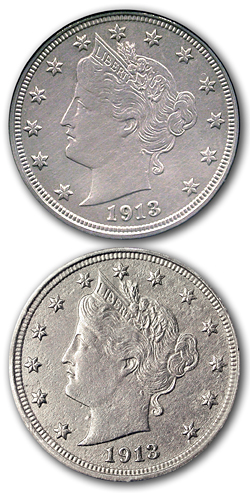The Famous "V" Nickel Mavericks
|
"Making Cents"
The Signal
Saturday, January 28, 2006
| B |
This design was one of four then-circulating coins designed by Mint Chief Engraver Charles Barber — the others being the dime, quarter and half dollar of 1892-1916.
The Liberty nickel series is best known for its two mavericks. The original 1883 design did not include the words "FIVE CENTS," and some enterprising persons gold-plated some of the new coins and applied reeding marks to the edges and passed off some of them for the very similar-looking $5 gold piece of the period. How many people actually were taken by the ruse is unknown, but at least one merchant was stuck with a so-called " "racketeer nickel."
Apparently many were later made as souvenirs; today you can find one online or at any coin show for a few dollars. The omission was corrected later in 1883 when the word "CENTS" was added to the coin below the "V." The "V" is the Roman numeral 5.
As a boy, I often found these nickels in change. Perhaps 1 to 5 percent of all nickels that were around during my childhood were "V" nickels. Unfortunately, my attempt to fill my Whitman folder with one of each year and date fell well short of the goal. The scarce coins just never showed up in circulation. They included 1884, 1885, 1886, and 1912-S.
These four coins are valued more than all other coins in the series combined (in similar grades). Today, average used "V" nickels dated 1910-1912 catalog for $1.75 each. The scarce dates in lower grades catalogue as follows: 1884, $13; 1885, $300; 1886, $125; and 1912-S, $80.
One story I heard as a boy was that the "V" stood for "Victory" in World War I. Since the war started and ended after this series, the myth was unfounded. It may have tied into the Peace dollar issued in 1921, which actually commemorated the end of World War I.
The other hallmark of the Liberty nickel series is the coin that everyone looked for but no one ever found in circulation — the famous 1913 "V" nickel.
Early in 1913, a U.S. Mint employee named Sam Brown had acquired five (possibly six) 1913 "V" nickels that had just been struck at the Philadelphia Mint. Chances are, they were made without authorization, and certainly not during a regular Mint work shift.
In the early 1920s, Brown sold the coins — either 5 or 6 of them — for several thousand dollars to a Philadelphia coin dealer who in turn sold them to the well-known and eccentric collector Col. E.H.R. Green. After Green died, the coins were dispersed to various private collections.
Today it is believed that only five coins existed, and for the first time since 1920, all five were on display at the same time at the American Numismatic Association coin show in Baltimore a few years ago.. Each is worth at least $1.5 million.
For a number of years in the 1930s and 1940s, coin dealer Max Mehl of Fort Worth, Texas, advertised widely that he would pay $50 for such a coin. He never got one that way, but he got lots of other coins from eager sellers.
This is one series that is relatively easy to complete (except for the 1913) by attending any major coin show and, for nicer graded coins, by attending any coin auction. Even with the scarce-date coins mentioned above, there are no rare coins in the series, except in very high Mint State grades.
Dr. Sol Taylor of Sherman Oaks is president of the Society of Lincoln Cent Collectors and author of The Standard Guide to the Lincoln Cent. Click here for ordering information.
©2006, THE SIGNAL · ALL RIGHTS RESERVED.
